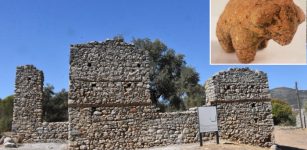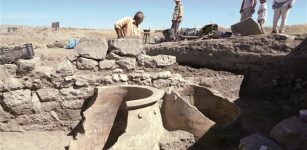Vesta And Her Six Vestal Virgins – Highly Venerated Goddess Of Hearth And Family
A. Sutherland - AncientPages.com - In ancient Roman beliefs, Vesta (the equivalent of the Greeks' Hestia) was the goddess of fire, home, and family.
She was an abstract goddess of the hearth, chastity, and ritual bonfires.
The goddess was rarely depicted in human form, and generally, no myths are associated with her. However, Vesta is one of the most important Roman divinities and probably one of the oldest European deities. She was one of the daughters of Saturn and Ops, a goddess of fertility and earth.
No temple or household began with their ceremonies until Vesta's fire was lit. The cult of Vesta, however, was religious worship that lay deep in our Indo-European past and was grown privately by individual families.
Also, the veneration of fire is an old tradition. Fire has been essential in human life since the dawn of history. The deification of fire is known from various Indo-European cultures. One of the most important deities in the Slavic pantheon was Svarog (Swarog), the god of celestial fire and the guardian of the Slavic home fire and the sacrificial fire. In Vedic India, people worshiped the fire-god Agni (which means: 'fire'), and the ancient Iranian Zoroastrians were famous fire-worshippers. Their concept of holy fire was Atar (fire god).
Officially, Vesta was represented by the sacred, eternal fire in her temple in the Roman Forum ('Forum Romanum'), considered the heart of ancient Rome.
Despite that worship of Vesta, and several other gods, had its roots in the Roman home, with time, it developed into an established cult during the reign of either Romulus or Numa Pompilius.
The latter is believed to have introduced her worship in Rome and constructed the temple in Vesta's honor, initially located on the slope of Palatine Hill. It was not an ordinary temple where gatherings could occur, as in other Roman temples.
 A vestal virgin. Gravy av Frederick Leighton, circa 1890. Public Domain
A vestal virgin. Gravy av Frederick Leighton, circa 1890. Public Domain
An eternal fire, representing Vesta, burned in the temple, and it ceased to exist in 394 AD at the order of the Christian Emperor Theodosius the Great, a Roman Emperor from 379 to 395. Theodosius (who also banned the pagan rituals of the Olympics in ancient Greece) dissolved the Order of the Vestal Virgins in Rome.
Vestals And Their Life After Thirty-Year-Long Service
Her priestesses - Vestals - were the virgins who kept and cared for the sacred fire that symbolized the existence of Rome (the 'eternal city').
According to tradition, six chosen vestals came to serve the goddess. These girls (seven to 10 years old and from good families) had to take a vow of chastity. If the vow was broken and the Vestal was found guilty, she was punished by being walled up in the Campus Sceleris ('Field of Wickedness') and left for her death.
The priestesses were freed of the usual social obligations to marry and bear children. Instead, they devoted themselves to the study and correcting state rituals that were off-limits to the male colleges of priests.
 Vestal virgin hanging an ivy wreath during Vestalia Festival. Carl Friedrich Deckler (1838–1918). Public Domain
Vestal virgin hanging an ivy wreath during Vestalia Festival. Carl Friedrich Deckler (1838–1918). Public Domain
The Vestals played an essential role in ancient Rome's ceremonial life. Besides guarding Vesta's fire, the Vestals often attended festivals, and their duties included making the so-called "salted flour" (mola salsa), a mixture sprinkled over the sacrificial animals. The Vestals served in the temple for thirty years before being replaced by new ones.
After thirty years, the Vestal could give up the priesthood, return to ordinary life and even get married. Few of them, however, used this right. Instead, they preferred to serve the goddess until their death.
Vestals could, with their own hands, without a guarantor, manage their affairs, which for the most part, were not allowed to other Roman women.
The Vestals in the service enjoyed great privileges and honors as a reward for their long and dedicated service. The consul himself at the meeting gave way to the vestals.
 Statues of the Vestal Virgins - in front of the Atrium Vestae. Image Credit: Carole Raddato - CC BY-SA 2.0
Statues of the Vestal Virgins - in front of the Atrium Vestae. Image Credit: Carole Raddato - CC BY-SA 2.0
Vestalia Festival That Honored The Goddess And Her Priestesses
Vesta was highly respected as the one who watched over the hearth, which provided light and warmth, nourishment, and protection to the family. In this way, she was a guardian of the Roman people, and as much as they divinized the hearth, they also honored Vesta's existence by organizing the Vestalia. It was one of the most celebrated Roman holidays from the 7th to the 15th of June each year.
During this holiday, married women made offerings in the form of food in Vesta's temple. It was also a festival of bakers; Vesta's priestesses baked special bread made of salted flour, and the mills were decorated with wreaths and flowers.
Written by – A. Sutherland - AncientPages.com Senior Staff Writer
Updated on March 30, 2024
Copyright © AncientPages.com All rights reserved. This material may not be published, broadcast, rewritten or redistributed in whole or part without the express written permission of AncientPages.com
Expand for referencesReferences:
Benjamin W. Fortson, IV, Indo-European Language, and Culture: An Introduction
Mary Beard M. North J. Religions of Rome: Volume 1
More From Ancient Pages
-
 Children’s Toys Among Roman-Era Artifacts Unearthed At Ancient City Of Beçin Turkey
Artifacts | Oct 14, 2020
Children’s Toys Among Roman-Era Artifacts Unearthed At Ancient City Of Beçin Turkey
Artifacts | Oct 14, 2020 -
 Viking Ship Found With Unexpected Goods For Unclear Purpose Puzzles Scientists
Vikings | Nov 24, 2024
Viking Ship Found With Unexpected Goods For Unclear Purpose Puzzles Scientists
Vikings | Nov 24, 2024 -
 Did Ancient Romans And Greeks Love As We Do? Perhaps Even More Hopelessly
Featured Stories | Jul 30, 2024
Did Ancient Romans And Greeks Love As We Do? Perhaps Even More Hopelessly
Featured Stories | Jul 30, 2024 -
 Hidden Role Of The Milky Way And Egyptian Goddess Nut Examined
Myths & Legends | Apr 15, 2024
Hidden Role Of The Milky Way And Egyptian Goddess Nut Examined
Myths & Legends | Apr 15, 2024 -
 Petronella Oortman And Her Giant Dolls’ House
Featured Stories | Jul 10, 2019
Petronella Oortman And Her Giant Dolls’ House
Featured Stories | Jul 10, 2019 -
 Ancient Egyptian Women Had Equal Rights As Men – Egyptian Cosmology And Goddess Maat Reveal Why
Ancient History Facts | Dec 18, 2017
Ancient Egyptian Women Had Equal Rights As Men – Egyptian Cosmology And Goddess Maat Reveal Why
Ancient History Facts | Dec 18, 2017 -
 Huge Jars Unearthed In Kultepe, Turkey
Archaeology | Sep 27, 2015
Huge Jars Unearthed In Kultepe, Turkey
Archaeology | Sep 27, 2015 -
 On This Day In History: Grote Reber, Great Amateur Astronomer And Ham Radio Operator Born – On Dec 22, 1911
News | Dec 22, 2016
On This Day In History: Grote Reber, Great Amateur Astronomer And Ham Radio Operator Born – On Dec 22, 1911
News | Dec 22, 2016 -
 Mabon Festival And The Autumn Equinox Celebrated By Pagans
Ancient Traditions And Customs | Sep 19, 2024
Mabon Festival And The Autumn Equinox Celebrated By Pagans
Ancient Traditions And Customs | Sep 19, 2024 -
 Burnt Mound Complex Dated To Bronze Age – Uncovered At Suffolk Site
Archaeology | Jun 19, 2023
Burnt Mound Complex Dated To Bronze Age – Uncovered At Suffolk Site
Archaeology | Jun 19, 2023 -
 Secrets About ‘Tennessee’s Ancient Egyptian Temple’ Revealed
Civilizations | Aug 15, 2018
Secrets About ‘Tennessee’s Ancient Egyptian Temple’ Revealed
Civilizations | Aug 15, 2018 -
 ‘Impossible’ Advanced Ancient Technology In Mesopotamia – Evidence Of Other-Worldly Interaction?
Ancient Mysteries | May 24, 2021
‘Impossible’ Advanced Ancient Technology In Mesopotamia – Evidence Of Other-Worldly Interaction?
Ancient Mysteries | May 24, 2021 -
 Atomic Theory Was Invented 2,600 Years Ago By Acharya Kanad – A Genius Ahead Of His Time
Featured Stories | May 15, 2014
Atomic Theory Was Invented 2,600 Years Ago By Acharya Kanad – A Genius Ahead Of His Time
Featured Stories | May 15, 2014 -
 On This Day In History: Battle of Tsushima Was Fought – On May 27, 1905
News | May 27, 2016
On This Day In History: Battle of Tsushima Was Fought – On May 27, 1905
News | May 27, 2016 -
 Biblical City In Zanoah Offers Archaeological Evidence Of Moses’ Journey To The Promised Land
Archaeology | Jul 18, 2024
Biblical City In Zanoah Offers Archaeological Evidence Of Moses’ Journey To The Promised Land
Archaeology | Jul 18, 2024 -
 Huge Statue Of Pharaoh Ramesses II Unearthed In The Ancient City Of Hermopolis
Archaeology | Mar 4, 2024
Huge Statue Of Pharaoh Ramesses II Unearthed In The Ancient City Of Hermopolis
Archaeology | Mar 4, 2024 -
 Stunning 2,400-Year-Old Mask Of God Dionysus Unearthed In Ancient City Of Daskyleion
Archaeology | Sep 7, 2020
Stunning 2,400-Year-Old Mask Of God Dionysus Unearthed In Ancient City Of Daskyleion
Archaeology | Sep 7, 2020 -
 Mystery Of The Ancient Reptilian Gods Remains A Complex Subject – Alien Worlds – Part 2
Ancient Mysteries | Feb 9, 2022
Mystery Of The Ancient Reptilian Gods Remains A Complex Subject – Alien Worlds – Part 2
Ancient Mysteries | Feb 9, 2022 -
 Legend Of Brigadoon: Mythical Village Where Time Stands Still
Featured Stories | Nov 2, 2016
Legend Of Brigadoon: Mythical Village Where Time Stands Still
Featured Stories | Nov 2, 2016 -
 What Is The History Of Pancakes?
Ancient History Facts | Mar 7, 2024
What Is The History Of Pancakes?
Ancient History Facts | Mar 7, 2024

